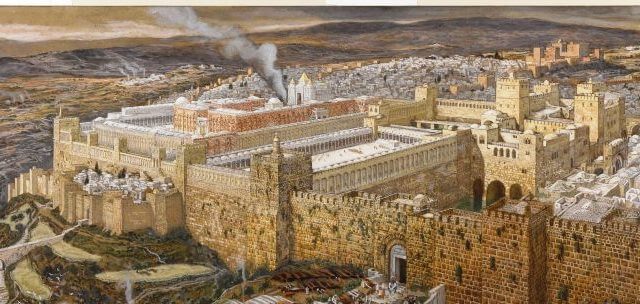Or did Har HaBayit lose its special status after the Beit Hamaikdash's destruction?
This issue was the subject of a major dispute some 900 years ago. Rambam noted that the status of Har HaBayit is not connected to the question about whether the Land of Israel in general retained its sanctity after the first exile to Babylonia. The sanctity of the place of the Temple is based on a unique source — the Divine Presence in that location – and that, Maimonides argued, has not changed. “The Shekhinah can never be nullified.”
Rambam buttressed his position by quoting the Mishnah in Megillah 3:4: “Even when [your sanctuaries] are in ruins, their holiness remains.
However, Rambam's’ famous adversary, Rav Abraham ben David (Ra’avad), disagreed vehemently. This ruling, Ra’avad wrote, is Rambam’s own opinion; it is not based on the rulings of the Talmud. After the Beit Hamaikdash’s destruction, Har HaBayitno longer retains its special sanctity. A ritually-impure individual who enters the place of the Beit Hamaikdash courtyard in our days does not incur the penalty of karet.
Rav Kook noted that even Ra’avad agrees that it is forbidden nowadays to enter the Beit Hamaikdash area while impure. It is not, however, the serious offence that it was when the Temple stood.

What is the source of this disagreement?
Like a Tallit or Like Tefillin?
In Halakhah there are two paradigms for physical objects that contain holiness. The lower level is called tashmish mitzvah. These are objects like a garment used for a Tallit, a ram’s horn used for a Shofar, or a palm branch used for a Lulav. All of these objects must be treated respectfully when they are used for a mitzvah. But afterwards, they may be freely disposed of (covered and then thrown in the garbage). Their holiness is only in force when they are a vehicle for a mitzvah. The holiness of a tashmish mitzvah is out of respect for the mitzvah that was performed with it.
But there is a second, higher level, called tashmish kedushah. These are objects which have an intrinsic holiness, as they are vessels for holy writings. This category includes Tefillin, Sifrei Torah, and Mezuzot. It also includes articles that protect them, such as covers for Sifrei Torah and Tefillin boxes. Unlike tashmishei mitzvah, these objects may not be simply disposed of when no longer used. They must be set aside (genizah) and subsequently buried.
For Ra’avad, the land under the Beit Hamaikdash falls under the category of tashmish mitzvah. It facilitated the many mitzvot that were performed in the Beit Hamaikdash . Without the Beit Hamaikdash , however, the area no longer retained its special kedushah. It became like an old Tallit, no longer used to bear tzitzit.
Rambam, on the other hand, categorized Har Habayit as a tashmish kedushah. This area was the location of the unique holiness of the Shekhinah, an eternal holiness. Like a leather box that once contained Tefillin scrolls, even without the Beit Hamaikdash this area retains its special level of kedushah.
“Sanctified by My Honor”
All this, Rav Kook suggested, boils down to how to interpret the words “וְנִקְדַּשׁ בִּכְבֹדִי” — “sanctified by My Honor” (Shemot 29:43). The Torah describes the holiness of the Mishkan — and later the Beit Hamaikdash :
“There I will meet with the Israelites, and [that place] will be sanctified by My Honor (Kevodi).”
What does the word Kevodi mean?
We could interpret Kevodi as referring to the honor (kavod) and reverence that we give this special place. The Mishkan and Beit Hamaikdash were deserving of special respect (like the mitzvah of mora Mikdash). But without the Beit Hamaikdash functioning, it no longer retains its former kedushah — like the opinion of Ra’avad.
On the other hand, the word Kevodi could be understood as referring to Kevod Hashem — the Shekhinah, God’s Divine Presence in the Beit Hamaikdash (see Rashi ad loc.). As the verse begins, “There I will meet with the Israelites.” This would indicate an intrinsic holiness which is never lost — like the opinion of Rambam.
In his Halakhic work Mishpat Kohen, Rav Kook explained our relationship to the place where the Beit Hamaikdash once stood:
“The Beit Hamaikdash is the place of revelation of the Shekhinah, the place of our encounter with God. We do not mention God’s holy Name outside the Beit Hamaikdash due to the profound holiness of His Name; so, too, we do not ascend Har HaBayit nor approach the Holy until we will be qualified to do so. And just as we draw closer to God by recognizing the magnitude of our inability to grasp Him, so too, we draw closer to Har HaBayit precisely by distancing ourselves from it, in our awareness of its great holiness.” (p. 204)
(Adapted from Igrot HaRe’iyah vol. III, letter 926 by Rav Chanan Morrison)


No comments:
Post a Comment